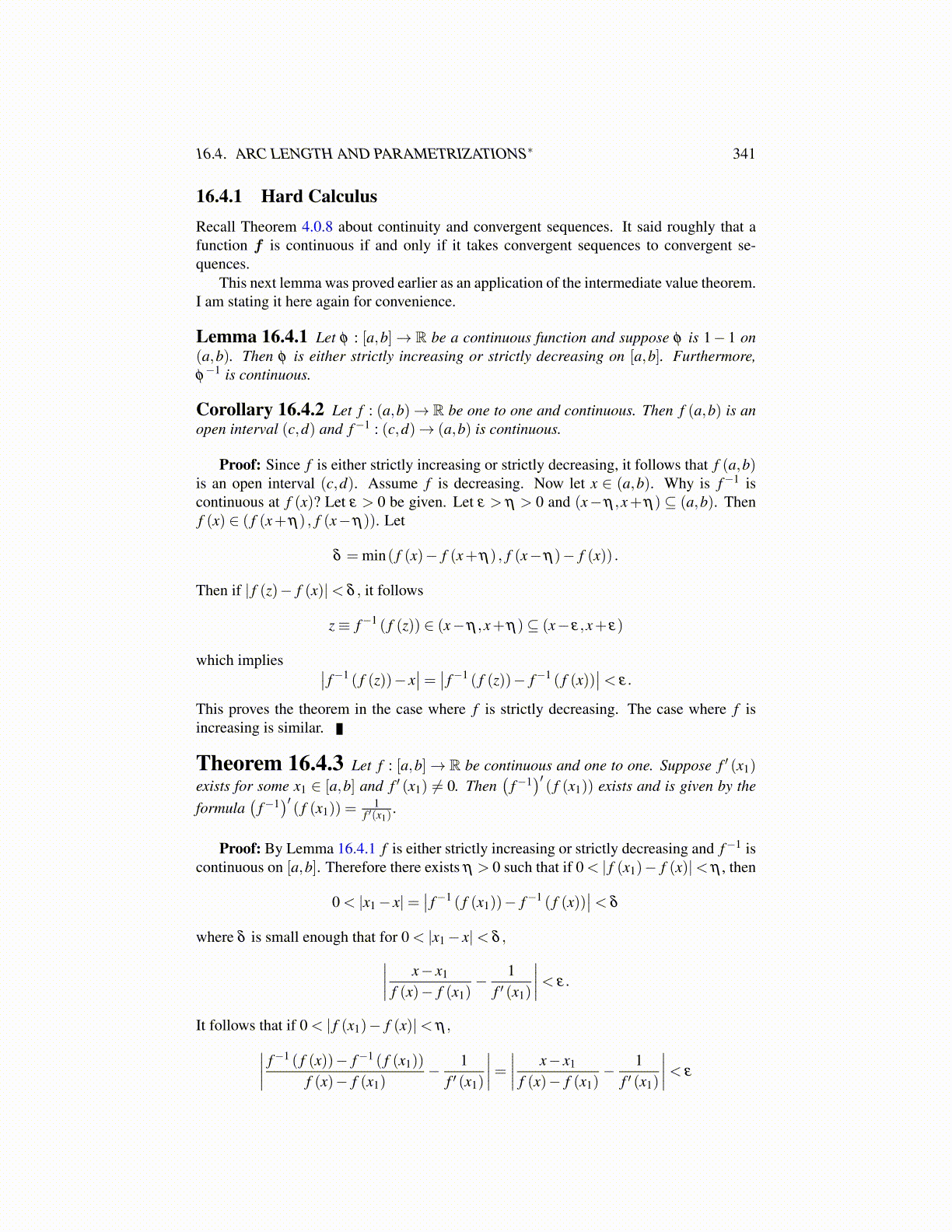
16.4. ARC LENGTH AND PARAMETRIZATIONS∗ 341
16.4.1 Hard CalculusRecall Theorem 4.0.8 about continuity and convergent sequences. It said roughly that afunction f is continuous if and only if it takes convergent sequences to convergent se-quences.
This next lemma was proved earlier as an application of the intermediate value theorem.I am stating it here again for convenience.
Lemma 16.4.1 Let φ : [a,b] → R be a continuous function and suppose φ is 1− 1 on(a,b). Then φ is either strictly increasing or strictly decreasing on [a,b]. Furthermore,φ−1 is continuous.
Corollary 16.4.2 Let f : (a,b)→ R be one to one and continuous. Then f (a,b) is anopen interval (c,d) and f−1 : (c,d)→ (a,b) is continuous.
Proof: Since f is either strictly increasing or strictly decreasing, it follows that f (a,b)is an open interval (c,d). Assume f is decreasing. Now let x ∈ (a,b). Why is f−1 iscontinuous at f (x)? Let ε > 0 be given. Let ε > η > 0 and (x−η ,x+η) ⊆ (a,b). Thenf (x) ∈ ( f (x+η) , f (x−η)). Let
δ = min( f (x)− f (x+η) , f (x−η)− f (x)) .
Then if | f (z)− f (x)|< δ , it follows
z ≡ f−1 ( f (z)) ∈ (x−η ,x+η)⊆ (x− ε,x+ ε)
which implies ∣∣ f−1 ( f (z))− x∣∣= ∣∣ f−1 ( f (z))− f−1 ( f (x))
∣∣< ε.
This proves the theorem in the case where f is strictly decreasing. The case where f isincreasing is similar.
Theorem 16.4.3 Let f : [a,b]→ R be continuous and one to one. Suppose f ′ (x1)
exists for some x1 ∈ [a,b] and f ′ (x1) ̸= 0. Then(
f−1)′( f (x1)) exists and is given by the
formula(
f−1)′( f (x1)) =
1f ′(x1)
.
Proof: By Lemma 16.4.1 f is either strictly increasing or strictly decreasing and f−1 iscontinuous on [ f (a), f (b)]. Therefore there exists η > 0 such that if 0 < | f (x1)− f (x)|<η , then
0 < |x1 − x|=∣∣ f−1 ( f (x1))− f−1 ( f (x))
∣∣< δ
where δ is small enough that for 0 < |x1 − x|< δ ,∣∣∣ x−x1
f (x)− f (x1)− 1
f ′(x1)
∣∣∣< ε . It follows thatif 0 < | f (x1)− f (x)|< η , then∣∣∣∣ f−1 ( f (x))− f−1 ( f (x1))
f (x)− f (x1)− 1
f ′ (x1)
∣∣∣∣= ∣∣∣∣ x− x1
f (x)− f (x1)− 1
f ′ (x1)
∣∣∣∣< ε
Therefore, since ε > 0 is arbitrary,
limy→ f (x1)
f−1 (y)− f−1 ( f (x1))
y− f (x1)=
1f ′ (x1)
.
The following obvious corollary comes from the above by not bothering with endpoints.